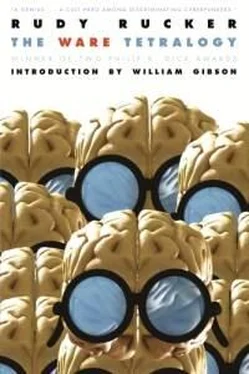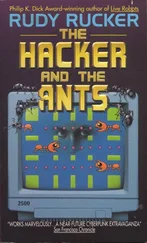Rudy Rucker - The Ware Tetralogy
Здесь есть возможность читать онлайн «Rudy Rucker - The Ware Tetralogy» весь текст электронной книги совершенно бесплатно (целиком полную версию без сокращений). В некоторых случаях можно слушать аудио, скачать через торрент в формате fb2 и присутствует краткое содержание. Год выпуска: 2010, Жанр: Киберпанк, на английском языке. Описание произведения, (предисловие) а так же отзывы посетителей доступны на портале библиотеки ЛибКат.
- Название:The Ware Tetralogy
- Автор:
- Жанр:
- Год:2010
- ISBN:нет данных
- Рейтинг книги:5 / 5. Голосов: 1
-
Избранное:Добавить в избранное
- Отзывы:
-
Ваша оценка:
- 100
- 1
- 2
- 3
- 4
- 5
The Ware Tetralogy: краткое содержание, описание и аннотация
Предлагаем к чтению аннотацию, описание, краткое содержание или предисловие (зависит от того, что написал сам автор книги «The Ware Tetralogy»). Если вы не нашли необходимую информацию о книге — напишите в комментариях, мы постараемся отыскать её.
The Ware Tetralogy — читать онлайн бесплатно полную книгу (весь текст) целиком
Ниже представлен текст книги, разбитый по страницам. Система сохранения места последней прочитанной страницы, позволяет с удобством читать онлайн бесплатно книгу «The Ware Tetralogy», без необходимости каждый раз заново искать на чём Вы остановились. Поставьте закладку, и сможете в любой момент перейти на страницу, на которой закончили чтение.
Интервал:
Закладка:
“Yes, the street moldies are very friendly to Emperor Staghorn employees because, of course, they are hoping you will be giving them imipolex. Some of us have moldie servants. When I was a younger man, I kept a moldie who was flying me to work like a great bird! Devilishly good fun. But finally it was becoming too great a financial outlay for a father of five. And too dodgy.”
“Dodgy?” asked Randy. “You mean like risky? To keep a moldie?”
“I will be telling you in due time what precautions you must be taking in your dodgy relations with low-caste moldies,” said Neeraj, starting to open a big door in the left wall. A breeze of pressurized air wafted out. “But that can wait a little bit. We are entering the pre-gowning area. We’ll get suited up and go into the main part of the fab, which is a clean room. Here we are allowing less than one dust particle per cubic meter of air.”
“Imipolex is that xoxxin’ sensitive?”
“Imipolex is a very highly structured quasicrystal,” said Neeraj. “While we are manufacturing the layers, the accidental inclusion of a dust particle can spoil the long-range Penrose correlations. And, of course, we are also producing the hybridized chipmold cultures here, and contamination by a wild fungus spore or by a stray algal germ cell would be disastrous. Keep in mind, Randy, that in the air, for instance, of the train you ride to work, there are perhaps a million particles per cubic meter, and very many of the particles are biologically active.”
The door to the pre-gowning room closed behind them. The floor was covered with sticky adhesive to catch the dust from their feet. Following Neeraj’s example, Randy sat down on a bench and pulled some disposable blue covers over his shoes.
“Ram-ram, Neeraj,” said a leathery brown woman sitting behind a counter. “Is this our new Mr. Tucker?”
“Indeed. Randy, this is Roopah. Roopah, this is Randy.”
“Here are your building suit, your shoes, and your ID badge,” said Roopah, setting what looked like tight-cuffed blue pajamas and white bowling shoes on the counter. “Press your thumb on this pad, Randy, so that your locker can recognize you. Your locker number is 239.”
In the locker room, they stashed their street clothes and put on the blue building suits and the white plastic shoes. Beyond the locker room lay a medium clean zone—with a mere ten thousand particles per cubic meter. Here the air already felt purer than any that Randy had ever breathed; the odorless air flowed effortlessly into his lungs.
Then they went into a second locker room: the gowning room proper. They put on latex gloves. They put on white hoods and overalls. Randy had hoped the suits might be live imipolex, but they were just brainless plastic.
“We call these bunny suits ,” said Neeraj, cheerfully pulling his hands up under his chin and making a chewing face like a rabbit. “And the floppy white galoshes are fab booties .”
They pulled the fab booties over their white bowling shoes. Neeraj gave Randy a face mask equipped with a small fan that drew in new air and pumped Randy’s exhalations through a filter. This was starting to feel a teensy bit . . . obsessive. But Randy liked being obsessive.
Now Neeraj led Randy through a tile corridor lined with nozzles blasting out air. “This is the air shower,” said Neeraj.
Slowly moving through the air shower, with his filthy invisible human particles being sucked out through the floor grate, Randy thought of a Bible phrase: “I was glad when they said unto me, let us go into the house of the Lord.”
Beyond the air shower lay the temple of moldie creation. The lights were bright and yellow; they gave the fab a strange underworld feeling. The rushing air streamed down past Randy from ceiling to floor. White-garbed figures moved about; all of them were dressed exactly the same. Everyone’s labors revolved around glowing cylindrical slugs of imipolex, the slugs ranging in size from breakfast sausages on up to giant bolognas four feet long.
The fab was perhaps the size of a football field, and it had high fifteen foot ceilings to accommodate an overhead monorail system that carried the partially processed slugs of imipolex from station to station.
The crude imipolex itself was manufactured in a series of vats, vacuum chambers, and distillation columns fed by slurries of chemicals piped up from somewhere below the floor.
As Randy and his boss moved down the main corridor on their tour, people kept recognizing Neeraj and coming over to pat him on the back or on the arm or on the stomach—they were like worker ants exchanging greetings while tending their larvae.
The only human contamination Randy could sense was the meaty smell of his own breath bouncing around inside his face mask. He wished he could tear off the mask and inhale the clean pure air of the fab. But then he would exhale, and the fab wouldn’t like that—detectors would notice the increased number of particles per cubic meter, and lights would flash.
Later they went downstairs to the sub fab , the floor below the fab. Like the break area, the sub fab was only kept at ten thousand particles per cubic meter, and you didn’t have to wear a face mask.
The sub fab was a techno dream, the ultimate mad scientist’s lab. It held all the devices needed to support the machines of the fab. The electrical generators were here, the plumbing, the tanks of acids, the filtering systems, the vacuum lines, the particle monitoring equipment—miles of wires and pipes and cables in an immaculately painted concrete room. This was where Randy was to begin work, maintaining and upgrading the sub fab’s plumbing.
The apartment the Heritagists had found for Randy was in a sterile high-rise right next to the Bangalore airport. Most of the people living in it were non-Indian workers and scientists imported by the various high-tech industries of Bangalore. After a tense, alienated week there, Randy decided to move into town, into the real India, into a dim room in an ancient stone building on the side of a hill between the orchid-filled Lalbagh Gardens and the bustling Gandhi Bazaar.
The sheer diversity of India soothed Randy: in uptight Louisville, everyone was good or bad, rich or poor, black or white—but in the streets of Bangalore there were endless shadings on every scale, and life’s daily workings were all the more richly woven.
The building with Randy’s room was called Tipu Bharat; Tipu being the name of a former Indian prince and Bharat being the Indian word for India. The walls of Tipu Bharat were worked with carved designs like necklaces and set with arched, pillared niches holding miniature bright imipolex statues of gods, animated icons that waved their tiny arms and seemed to watch the passersby. There was an open terrace on the roof where the Tipu Bharat roomers could sit and stare out toward the Eastern or the Western Ghats, the distant mountain ranges that enclosed the high plateau of Bangalore.
Near the Gandhi Bazaar was a street of the naked holy men called sadhus; day and night the sadhus sat in streetside booths, each with a small incense burner, a blanket, a fly whisk, and a tacked-up collection of shimmering religious art, much of it made of imipolex. Sometimes one of the sadhus would put on a show: hammer a sharpened stick into his head, build a fire in the street and walk on its coals, suck blood from the neck of a live chicken, or do something even more fantastic and disgusting. Randy often walked down to watch them in the evenings.
“The moldie you are always fabulating with outside the fab,” said Neeraj on the morning of Randy’s first monthly payday, a Saturday. “Is she calling herself Parvati?”
“Mm-hmm,” said Randy. “Do you know her?”
Читать дальшеИнтервал:
Закладка:
Похожие книги на «The Ware Tetralogy»
Представляем Вашему вниманию похожие книги на «The Ware Tetralogy» списком для выбора. Мы отобрали схожую по названию и смыслу литературу в надежде предоставить читателям больше вариантов отыскать новые, интересные, ещё непрочитанные произведения.
Обсуждение, отзывы о книге «The Ware Tetralogy» и просто собственные мнения читателей. Оставьте ваши комментарии, напишите, что Вы думаете о произведении, его смысле или главных героях. Укажите что конкретно понравилось, а что нет, и почему Вы так считаете.











